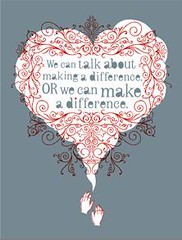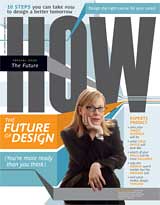100 Episodes: A Very Special Design Matters Milestone with guest DeeDee Gordon
Design Matters began in February of 2005 with an idea and a telephone line. Mostly, I started out doing it for myself--I thought it would be a great way to ask my heroes everything I wanted to know about their lives and their thoughts and their careers without seeming stalker-y. In the process, I gleaned the most magnificent view of some of the greatest design thinkers and practitioners of our time. I realized the opportunity to share the brilliance of my guests with a listenership I never expected was the gift of a lifetime.
Today marks my 100th broadcast of Design Matters and joining me for the show is DeeDee Gordon.
DeeDee Gordon is renowned youth culture expert and she has been at the forefront of youth culture and trend research for over 15 years. While working as Director of Research and Product Development for ad agency Lambesis, Gordon broke new ground in the standards of youth market research by co-creating the famed L Report, the first national marketing research report to track trend diffusion among youth. In 1999, Gordon became a pioneer in the field of research by taking youth culture research on-line co-founding Look-Look, Inc., a one-of-a-kind research, marketing and trend on-line consulting company specializing in youth culture. Look-Look grew to be the largest global community of 14-35 year-old youth to report on their own culture. Look-Look’s proprietary panel and database technology allowed them to exceed the capabilities of competing marketing companies by maintaining a constant 2-way dialogue with trendsetting and mainstream young people from around the world. From product research, to trend reports, to brand development, this communication methodology distinguished Look-Look’s high-quality product offerings. Clientele such as Calvin Klein, Audi, Microsoft, Universal Pictures, Nike and Virgin Mobile relied on Look-Look for expertise and instant access to information on global youth culture. As co-president at Look-Look, Inc., Gordon oversaw all research analysis, product development and creative direction for client accounts and Look-Look consumer products, and directed the marketing solutions of the company.
In the fall of 2003, Gordon once again broke new ground by launching Look-Look Magazine, a one-of-a-kind publication, providing a forum and an opportunity for young artists, photographers and writers around the world to have their work published. All profits of the magazine went to the Look-Look Arts Foundation, established to assist young people with pursuing their passion in the Arts. Recognized internationally for being a leader in youth culture, Gordon’s research and reputation have been featured in numerous media outlets including Malcolm Gladwell’s “The Tipping Point,” Good Morning America, CNN, The New Yorker, Vogue, Time, Los Angeles Times and The New York Times Magazine, who deemed her the interpreter of youth culture in 2005. Most notably, Look-Look, Inc. was featured on PBS’s Frontline Special “Merchants of Cool,” which is used in marketing curriculum for numerous college classrooms today.
Design Matters airs live weekly on the Voice America Business Network, now the industry leader in Internet talk radio. The show was voted a "favorite podcast" on PSFK's Marketing Podcast survey, it was voted 9th out of over 300 entries for the Cooper Hewitt National Design Museum’s People’s Choice Award in 2007, and was recently nominated for a Bloggy for best podcast . The show is also available as Podcasts on iTunes, where over 100,000 people download the show every month.
Design Matters is from 3-4PM EST and you can view the VoiceAmerica Business site and listen to the show from a myriad of locations: You can go here, through the Sterling link: http://www.sterlingbrands.com/design/design_matters.php
Or you can go here, through the Voice America link: http://www.modavox.com/VoiceAmericaBusiness/
On behalf of all of my amazing guests listed below, I want to thank you for supporting the show, and for offering encouragement and friendship.
Abbott Miller
Alan Dye
Alice Twemlow
Allan Chochinov
Andrea Dezsö
Andrew Zolli
Ann Willoughby
Art Chantry
Bad Boys of Design 1: Armin Vit, Mark Kingsley, Michael Ian Kaye, Petter Ringbom, James Victore
Bad Boys of Design 2: Rodrigo Corral, Bennett Peji, Tan Le, Felix Sockwell, Mark English, John Zapolski
Bad Boys of Design 3: Josh Chen, Manuel Toscano, Layne Braunstein, Alan Dye
Bad Boys of Design 4: Marc Alt, Mike Essl, Ray Fenwick, Michael Jager, Alberto Rigau
Barbara Kruger
Bill Grant
Brian Collins
Carin Goldberg
Cheryl Swanson
Chip Kidd, part 1
Chip Kidd, part 2
Christoph Niemann
Dan Formosa
Daniel Pink
David Barringer
DeeDee Gordon
Design Blogs: Speak Up, Design Observer, Be A Design Group + Personism
David Carson, Not
Doyald Young
Eames Demetrios
Ed Fella
Editorial Women: Joyce Kaye, Michela Abrahms, Laetitia Wolff + Barbara de Wilde
Ellen Lupton
Elliott Earls
Emily Oberman
Eric Kandel
Gael Towey
Gary Hustwit
Gong Szeto
Gordon Hull
Grant McCracken, part 1
Grant McCracken, part 2
Grant McCracken, part 3
Hillman Curtis
Jakob Trollbäck
Janet Froelich
Jan Wilker + Hjalti Karlsson
Jeffrey Keyton
Jeffrey Zeldman
Jessica Helfand
Joe Duffy with guest host Nate Voss
John Fulbrook
John Maeda
Jonah Lehrer
Jonathan Hoefler + Tobias Frere-Jones
Josh Liberson + Ethan Trask
Kenneth Fitzgerald
Kurt Andersen
Laurie Rosenwald
Lisa Francella + Pamela DeCesare
Luke Hayman
Luba Lukova
Maira Kalman
Malcolm Gladwell + Joyce Gladwell
Marian Bantjes, Alexander Gelman + Michael Surtees
Marty Neumeier
Michael Bierut
Mick Hodgson
Milton Glaser
Minda Gralnek
Modern Dog
Natalia Ilyin
Neville Brody
Nicholas Blechman
Paola Antonelli
Patrick Coyne
Paul Sahre
Paula Scher
Peter Buchanan-Smith
Petrula Vrontikis
Rick Valicenti
Sean Adams + Noreen Morioka
Seth Godin
Shepard Fairey
Spoken Word
Stanley Hainsworth
Stefan Bucher
Stefan Sagmeister
Steve Sikora, Charlie Lazor + Tom Wright
Steven Heller, part 1
Steven Heller + Veronique Vienne
Steven Heller, part 3
Steven Heller + Lita Talerico
Todd Pruzan + Sam Potts
Vaughan Oliver
Virginia Postrel
William Drenttel + Jessica Helfand
William Lunderman
World of Branding
World of Las Vegas
World of Leisurama: Jake Gorst, Alastair Gordon + Andrew Geller
Y Conference 2009: Lorraine Wild, Liz Danzico, Andrea Pellegrino, Mark Randall, Shel Perkins
Ze Frank
Until Season Six--watch for wonderful new things!
Love
-debbie
Today marks my 100th broadcast of Design Matters and joining me for the show is DeeDee Gordon.
DeeDee Gordon is renowned youth culture expert and she has been at the forefront of youth culture and trend research for over 15 years. While working as Director of Research and Product Development for ad agency Lambesis, Gordon broke new ground in the standards of youth market research by co-creating the famed L Report, the first national marketing research report to track trend diffusion among youth. In 1999, Gordon became a pioneer in the field of research by taking youth culture research on-line co-founding Look-Look, Inc., a one-of-a-kind research, marketing and trend on-line consulting company specializing in youth culture. Look-Look grew to be the largest global community of 14-35 year-old youth to report on their own culture. Look-Look’s proprietary panel and database technology allowed them to exceed the capabilities of competing marketing companies by maintaining a constant 2-way dialogue with trendsetting and mainstream young people from around the world. From product research, to trend reports, to brand development, this communication methodology distinguished Look-Look’s high-quality product offerings. Clientele such as Calvin Klein, Audi, Microsoft, Universal Pictures, Nike and Virgin Mobile relied on Look-Look for expertise and instant access to information on global youth culture. As co-president at Look-Look, Inc., Gordon oversaw all research analysis, product development and creative direction for client accounts and Look-Look consumer products, and directed the marketing solutions of the company.
In the fall of 2003, Gordon once again broke new ground by launching Look-Look Magazine, a one-of-a-kind publication, providing a forum and an opportunity for young artists, photographers and writers around the world to have their work published. All profits of the magazine went to the Look-Look Arts Foundation, established to assist young people with pursuing their passion in the Arts. Recognized internationally for being a leader in youth culture, Gordon’s research and reputation have been featured in numerous media outlets including Malcolm Gladwell’s “The Tipping Point,” Good Morning America, CNN, The New Yorker, Vogue, Time, Los Angeles Times and The New York Times Magazine, who deemed her the interpreter of youth culture in 2005. Most notably, Look-Look, Inc. was featured on PBS’s Frontline Special “Merchants of Cool,” which is used in marketing curriculum for numerous college classrooms today.
Design Matters airs live weekly on the Voice America Business Network, now the industry leader in Internet talk radio. The show was voted a "favorite podcast" on PSFK's Marketing Podcast survey, it was voted 9th out of over 300 entries for the Cooper Hewitt National Design Museum’s People’s Choice Award in 2007, and was recently nominated for a Bloggy for best podcast . The show is also available as Podcasts on iTunes, where over 100,000 people download the show every month.
Design Matters is from 3-4PM EST and you can view the VoiceAmerica Business site and listen to the show from a myriad of locations: You can go here, through the Sterling link: http://www.sterlingbrands.com/design/design_matters.php
Or you can go here, through the Voice America link: http://www.modavox.com/VoiceAmericaBusiness/
On behalf of all of my amazing guests listed below, I want to thank you for supporting the show, and for offering encouragement and friendship.
Abbott Miller
Alan Dye
Alice Twemlow
Allan Chochinov
Andrea Dezsö
Andrew Zolli
Ann Willoughby
Art Chantry
Bad Boys of Design 1: Armin Vit, Mark Kingsley, Michael Ian Kaye, Petter Ringbom, James Victore
Bad Boys of Design 2: Rodrigo Corral, Bennett Peji, Tan Le, Felix Sockwell, Mark English, John Zapolski
Bad Boys of Design 3: Josh Chen, Manuel Toscano, Layne Braunstein, Alan Dye
Bad Boys of Design 4: Marc Alt, Mike Essl, Ray Fenwick, Michael Jager, Alberto Rigau
Barbara Kruger
Bill Grant
Brian Collins
Carin Goldberg
Cheryl Swanson
Chip Kidd, part 1
Chip Kidd, part 2
Christoph Niemann
Dan Formosa
Daniel Pink
David Barringer
DeeDee Gordon
Design Blogs: Speak Up, Design Observer, Be A Design Group + Personism
David Carson, Not
Doyald Young
Eames Demetrios
Ed Fella
Editorial Women: Joyce Kaye, Michela Abrahms, Laetitia Wolff + Barbara de Wilde
Ellen Lupton
Elliott Earls
Emily Oberman
Eric Kandel
Gael Towey
Gary Hustwit
Gong Szeto
Gordon Hull
Grant McCracken, part 1
Grant McCracken, part 2
Grant McCracken, part 3
Hillman Curtis
Jakob Trollbäck
Janet Froelich
Jan Wilker + Hjalti Karlsson
Jeffrey Keyton
Jeffrey Zeldman
Jessica Helfand
Joe Duffy with guest host Nate Voss
John Fulbrook
John Maeda
Jonah Lehrer
Jonathan Hoefler + Tobias Frere-Jones
Josh Liberson + Ethan Trask
Kenneth Fitzgerald
Kurt Andersen
Laurie Rosenwald
Lisa Francella + Pamela DeCesare
Luke Hayman
Luba Lukova
Maira Kalman
Malcolm Gladwell + Joyce Gladwell
Marian Bantjes, Alexander Gelman + Michael Surtees
Marty Neumeier
Michael Bierut
Mick Hodgson
Milton Glaser
Minda Gralnek
Modern Dog
Natalia Ilyin
Neville Brody
Nicholas Blechman
Paola Antonelli
Patrick Coyne
Paul Sahre
Paula Scher
Peter Buchanan-Smith
Petrula Vrontikis
Rick Valicenti
Sean Adams + Noreen Morioka
Seth Godin
Shepard Fairey
Spoken Word
Stanley Hainsworth
Stefan Bucher
Stefan Sagmeister
Steve Sikora, Charlie Lazor + Tom Wright
Steven Heller, part 1
Steven Heller + Veronique Vienne
Steven Heller, part 3
Steven Heller + Lita Talerico
Todd Pruzan + Sam Potts
Vaughan Oliver
Virginia Postrel
William Drenttel + Jessica Helfand
William Lunderman
World of Branding
World of Las Vegas
World of Leisurama: Jake Gorst, Alastair Gordon + Andrew Geller
Y Conference 2009: Lorraine Wild, Liz Danzico, Andrea Pellegrino, Mark Randall, Shel Perkins
Ze Frank
Until Season Six--watch for wonderful new things!
Love
-debbie

















